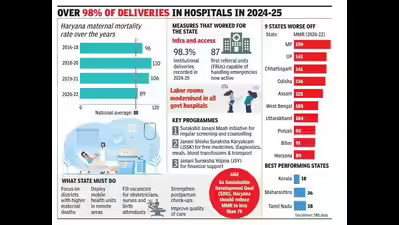Haryana Records Major Improvement in Maternal Mortality Ratio (MMR)

Haryana Records Major Improvement in Maternal Mortality Ratio (MMR)
Haryana has achieved a notable 17-point reduction in its Maternal Mortality Ratio (MMR), dropping from 106 (2018–20) to 89 (2020–22), according to the latest Sample Registration System (SRS) bulletin released by the Registrar General of India (RGI).This improvement translates to around 300 additional mothers surviving childbirth during the period, bringing the state almost in line with the national average of 88.
Key Factors Behind the Improvement:
- Institutional Deliveries Surge to Over 98%:
Enhanced public confidence in government healthcare services, supported by emergency obstetric care units and high-risk pregnancy protocols, has led to a significant increase in safe, institutional deliveries.“This surge reflects growing public trust in government health services,” said Dr. R.S. Dhillon, Mission Director, National Health Mission (NHM), Haryana.
- Infrastructure Modernisation:
Labour rooms across government hospitals have been modernised with essential equipment, supplies, and drugs to ensure safe birthing conditions. - Strengthened Referral System:
The number of First Referral Units (FRUs) — capable of handling obstetric emergencies, including C-sections — has increased to 87, improving emergency response capacity. - Focused Schemes and Protocols:
Implementation of key maternal health initiatives such as:- Surakshit Janani Maah
- Extended Pradhan Mantri Surakshit Matritva Abhiyan (e-PMSMA)
- Janani Shishu Suraksha Karyakram (JSSK) and Janani Suraksha Yojana (JSY)
- Maternal Death Reviews & Tracking Systems:
Regular maternal death audits and high-risk pregnancy tracking have strengthened accountability and early intervention mechanisms.
Challenges Ahead:
Experts like Dr. D.B. Saharan, former Director of Health Services, have highlighted the need for sustained accountability, equity, and education to reach the Sustainable Development Goal (SDG) 3.1 target — reducing MMR below 70 per lakh live births by 2030.
Significance:
- Reflects the impact of targeted public health interventions and systematic healthcare improvements.
- Positions Haryana among the better-performing states in maternal health outcomes.
- Reinforces India’s progress toward achieving SDG 3 (Good Health and Well-being) and National Health Policy 2017 goals.
Updated - Jun 14, 2025, 02:10 PM | TOI
Haryana Maternal Mortality Ratio Sample Registration System Registrar General of India NHM Haryana Dr R.S. Dhillon D.B. Saharan Institutional Deliveries Surakshit Janani Maah e-PMSMA JSSK JSY Maternal Health Public Health Infrastructure Sustainable Development Goals SDG 3.1 Health Ministry Eminent IAS Notes UPSC Current Affairs